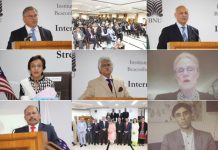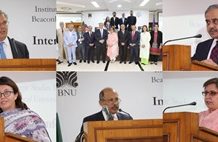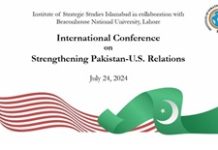Political cycles have a life of their own and often spin out of control, whether the rulers like it or not. It is obvious that Musharraf has lost political options and the moves he is likely to make to retain power may not work as well as he expects them to
President General Pervez Musharraf had ruled the country for over seven years without a major challenge to his authority until his attempt to oust the Chief Justice of Pakistan backfired. Once in power, he made the smart move of exiling Prime Minister Nawaz Sharif for ten years under a dubious agreement. He then warned Benazir Bhutto, the other former prime minister, by insisting that she would have to face the courts if she tries to return to Pakistan. With the leaders of the two major political parties out of the picture, Musharraf rearranged the politics of Pakistan according to his vision. He brought the religious parties on his side, and with their support, passed the 17th amendment to the Constitution legitimising his rule. The religious parties, in turn, formed an exclusive government in NWFP, shared power in Balochistan, and became a serious political entity in the system created by Musharraf.
Like his predecessors Ayub Khan and Zia-ul Haq, Musharraf tried to obtain popular legitimacy through a referendum. This referendum was also provided constitutional cover by the 17th amendment.
Another significant move to cement his position in the politics of Pakistan was putting together a party of individuals and groups that would support his rule. Musharraf knew that a significant portion of the mainstream parties’ support base was shallow and could be co-opted. After sidelining the two main political leaders of the country, he reached out to the lower-tier leaders of the major parties. Almost overnight, hundreds of assembly members switched political sides by quitting their former parties. A large number of them joined the PMLQ, and others established new variants of their old parties to gain better leverage over the distribution of political rewards. All the turncoats have pretensions of being representatives and have continued to claim democratic credentials on account of having plurality of votes in “competitive” elections. It is the poor quality of our democracy, if it is one at all, and low level of civic culture that the same lot get elected, no matter which party they belong to.
The current assemblies, elected under this façade of democracy, appear set to re-elect Musharraf in the last weeks of their tenure. However, will the president’s political support system hold together in the face of mounting opposition?
The current system is driven by the political ambition and vision of Musharraf. Like other military rulers of this country, he has a pessimistic view of our political parties and their leaders. He does not want to completely discard the political process, but wants to control it in a way that every party and leader stays behind the dotted line. He has succeeded in aligning most of them to his vision, and cares little about their complaints and objections.
However, political cycles have a life of their own and often spin out of control, whether the rulers like it or not. It is obvious that Musharraf has lost political options and the moves he is likely to make to retain power may not work as well as he expects them to. He will face four major challenges in the months and years ahead. His success or failure in confronting a significantly different political environment will determine the stability of the regime and continuity of the system he has created.
The first challenge is the independence of the judiciary which has popular support from several sections of society. This will force Musharraf to work strictly within the limits of the Constitution. Any attempt to bring the judiciary under the influence of the executive by legislative measures or constitutional amendments will only aggravate the legitimacy crisis of the system which has not really disappeared, even after eight years of stable rule. If the regime and its chief architect follow the Constitution, it will allow them a safe exit and stabilise the political environment.
Second, although the opposition parties have proved ineffective so far in mobilising the masses against the regime, they may acquire greater power and capacity to launch a political movement after the elections. It is important to recall the 1977 elections where the PPP had grossly underestimated the unified power of the opposition parties. However, a large-scale opposition movement is not inevitable. It will depend on whether the elections are free, fair and transparent.
The third challenge is keeping the ruling coalition intact. They are currently united by political interest and expediency, and not by any ideology or programme. However, it is an inherently weak and opportunistic ruling coalition, and would stick together only if the regime is stable. If they see signs of serious trouble for the ruling arrangement, they may decide to take a different political direction. A good number of them have already decided to join opposition parties. More will jump ship if the political weather worsens.
Finally, even if Benazir Bhutto returns under an arrangement with the regime which the PPP continues to deny the politics of Pakistan will undergo a fundamental change. With Bhutto and her party mobilising its latent constituency and gathering mass support, the locus of politics will shift to the streets. Other parties by necessity will follow Bhutto in organising protests, rallies and grand political gatherings.
The risk for the regime is that it may itself become a major electoral controversy. The opposition parties have already placed the political system at the centre of their campaign demanding pre-October 1999 constitutional status. Benazir Bhutto might be willing to make compromises but not without major concessions from the regime on two vital issues: sovereignty of the parliament, and Musharraf as a civilian president. In this case, the system will change significantly, and possibly allow Musharraf a safe exit. Given these challenges, and the danger that mass political agitation on the streets could go out of control, the regime as well as opposition parties will have to choose their moves very carefully.
The author is a professor of Political Science at the Lahore University of Management Sciences.













